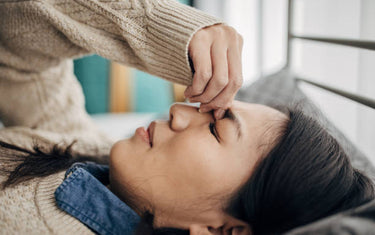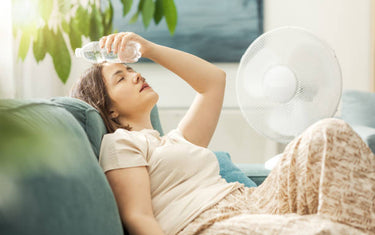6 min read / 24 December 2023 / yasmin sharp
Peppermint Oil for Headaches: How to Use It
Explore the benefits of using peppermint oil for headaches and migraines. Say goodbye to headache pain naturally.
Share this post

Using peppermint oil for headaches and migraines could help to alleviate the painful symptoms you are experiencing.
Essential oils offer a natural alternative to over-the-counter painkillers and can also be used to complement their headache-relieving abilities.
Everyone experiences a headache at some point, although for some it can be an almost daily experience that can affect their quality of life.
According to the World Health Organisation, up to 1 adult in 20 has a headache every – or nearly every – day. [1]
In this article we explain more about how to dilute peppermint oil for headaches, where to apply it and lots of other helpful ideas that can offer some much-needed relief.
Can I use peppermint oil for headaches?Several studies have been published about the effects of peppermint oil on headaches, with research still ongoing. For example, this review of essential oils and aromatherapy suggested that using peppermint oil could help to ease headache symptoms. [2] In the US, the National Centre for Complementary and Integrative Health, also point towards research that states tension headaches can be cured using peppermint oil. [3] The main constituent of peppermint oil is menthol, which accounts for about 44% of its chemical make-up. Researchers have also looked at the effectiveness of menthol as a headache cure, finding that using a topical gel with about 5% menthol decreased pain intensity only after a couple of hours. [4] This means peppermint oil can be used as a natural remedy for headaches, and for some of the other symptoms that come with tension, migraine, sinus and cluster headaches. |
Can I use peppermint oil for migraines?
Migraines are a more intense form of headache, with most people experiencing a throbbing pain on one side of their head.
You can use peppermint oil for migraines to ease the pain and some other associated symptoms such as dizziness, nausea, increased sensitivity to light, sound or smell and extreme tiredness.

How can I use peppermint oil for headaches?
If you want to use peppermint essential oil for headaches, you could try:
1. Inhaling peppermint essential oil with steam
Steam inhalation can be very effective at helping to clear sinus headaches, easing and cleaning congestion build ups.
To inhale the properties of peppermint oil with steam, you’ll need to add 3-7 drops into a bowl of hot water.
Place a towel over your head, close your eyes and lean in close to the bowl so you can breathe in the vapour through your nose.
Repeat this for no longer than 2 minutes at a time.
2. Diffusing peppermint oil into the air
Another popular method for clearing headaches with peppermint oil is to inhale via diffusion.
There are a few different types of diffusers you can use, including reed sticks, electric and even oil burners, so follow the instructions provided with the product.
You can also inhale the oil directly from the bottle, which allows you to bring it with you outside the house.
If you think the scent is too strong, place a few drops on a tissue, handkerchief, cotton ball or cloth and breathe in.
3. Mixing peppermint oil into a warm bath
For particularly intense headaches, adding a few diluted drops of peppermint oil to warm bath water can reduce its strength.
The properties will be released through the vapours, allowing you to naturally breathe in the health benefits.
If the lights are too heavy on your eyes, try dotting a few tea lights around the space to aid your relaxation.
This is a good method to try to calm an existing headache or to prevent one from coming on.
4. Using peppermint oil as a massage oil
You should be diluting peppermint oil for headaches if you are thinking of applying it topically to your skin.
This is because essential oils are highly concentrated and can cause sensitivity or allergy issues for some people.
If you have an allergy to peppermint, you should avoid using peppermint oil entirely.
To carry out a patch test, simply mix 3-5 drops of peppermint essential oil with one tablespoon of carrier oil.
Place this on the inside of your elbow and cover with a plaster for 24 hours.
If you do not see any reaction during this time, it should be safe to continue using the oil.
If you’re unsure where to apply peppermint oil for headaches, follow the steps below:
- Mix the peppermint oil with a carrier oil.
- Dab a couple drops of the mixture onto your fingers.
- Massage onto your temples, back of neck, shoulders and chest.
Some studies have found that a simple 30-minute massage can relieve headaches in as little as 24 hours. [5]
So, if you regularly suffer from headaches, incorporating this into your routine could quicken your recovery time.
5. Drink a cup of peppermint tea
Whilst you should not consume peppermint essential oil, as it can cause health complications, you could try making a peppermint tea using a peppermint tea bag.
Not only can it ease your headache symptoms, but researchers believe it could make you feel more alert and help you think more clearly. [6]

How to prevent a headache
Not all headaches arrive out of the blue, as some are caused by specific triggers.
If you know why you have a headache, there are a few other things you can do for additional relief:
- Pain: Paracetamol can ease some headaches but if you prefer not to take a pill, you could apply a cold pack to your head.
- Dehydration: Caffeine, sweet drinks and soda can increase dehydration, so drink more water or perhaps a sports drink to quickly rehydrate yourself.
- Stress: High stress and anxiety levels can cause headaches, so you could try to inhale lavender essential oil to ease the symptoms.
- Hangover: Water and sleep are the key to easing an alcohol-related headache. Electrolytes also help, which can be found in fruit juice, bananas, coconut water, white meat and dairy products.
- Bright lights: If the bright lights in your immediate space are affecting your head, take a break and walk out of the room to let your eyes and head rest.
Bad posture can also create a headache, so try to correct your body if you have a tight neck or shoulders.
Drink 1-2 litres of water a day to stay hydrated and try taking regular hot baths, as these can help to prevent headaches by helping you to relax.
What are the risks of using peppermint oil for headaches?
Peppermint essential oil is safe for most people, although it should always be diluted with a carrier oil before topical application.
First-time users should complete a patch test to ensure it is compatible with their skin.
If you have gallstones, heartburn, gallbladder disease or kidney problems, you should avoid using peppermint oil.
Ideally, people that are pregnant or breastfeeding should avoid using peppermint essential oil, as there is not enough evidence to suggest that it is safe.
Lastly, do not give peppermint oil to infants or children, which includes orally, topically or via inhalation.

Using peppermint oil for headaches allows you to try a natural method that can ease the pain and put you back in control of your body.
Depending on your preference or the headache type, you can diffuse, inhale and or use the oil topically, with peppermint tea which can cure it for some people.
There are also a few other things you can do to ease headache symptoms, which can offer relief from pain, stress and dehydration.
Most headaches tend to clear within a day or two, but if it continues or the symptoms become worse, you should book an appointment to speak with your doctor.
[1] W.H.O. (2014) Headache disorders: How common are headaches? https://www.who.int/news-room/questions-and-answers/item/headache-disorders-how-common-are-headaches
[2] Babar Ali et al. (2015) Essential oils used in aromatherapy: A systemic review https://www.sciencedirect.com/science/article/pii/S2221169115001033
[3] N.I.H. Peppermint Oil https://www.nccih.nih.gov/health/peppermint-oil
[4] Andrea St. Cyr et al. (2015) Efficacy and Tolerability of STOPAIN for a Migraine Attack https://www.ncbi.nlm.nih.gov/pmc/articles/PMC4316718/
[5] Albert F. Moraska et al. (2016) Myofascial trigger point-focused head and neck massage for recurrent tension-type headache: A randomized, placebo-controlled clinical trial https://www.ncbi.nlm.nih.gov/pmc/articles/PMC4286457/
[6] Mark Moss et al. (2016) Acute consumption of Peppermint and Chamomile teas produce contrasting effects on cognition and mood in healthy young adults https://horizonepublishing.com/journals/index.php/PST/article/view/246









